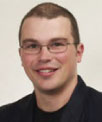Biomaterials for Brain Tissue Engineering
Jerani T. S. Pettikiriarachchi A , Clare L. Parish B , Molly S. Shoichet C , John S. Forsythe A and David R. Nisbet A D EA Department of Materials Engineering, Monash University, Vic. 3800, Australia.
B Florey Neuroscience Institutes, University of Melbourne, Parkville, Vic. 3010, Australia.
C Department of Chemical Engineering and Applied Chemistry, University of Toronto, 200 College Street, Toronto, ON M5S 3E5, Canada.
D The Mental Health Research Institute of Victoria, Parkville, Vic. 3010, Australia.
E Corresponding author. Email: david.nisbet@eng.monash.edu.au

Jerani Pettikiriarachchi completed her Bachelor of Science and Engineering double degree in 2008 at Monash University. She was awarded an Australian Postgraduate Award scholarship to pursue postgraduate studies in Biomaterials Engineering at Monash University under the supervision of Dr John Forsythe and Dr David Nisbet. In 2010, she successfully transferred from a Masters degree to Ph.D. Jerani’s research is focussed on the fabrication of biologically functional nanofibrous scaffolds for spinal cord injury applications. |

Clare Parish completed her undergraduate studies in Biomedical Science at Monash University, Australia. She obtained a Ph.D. in neuroanatomy from Monash in 2002. Dr Parish received two training fellowships (Human Frontiers Science Program longterm training fellowship and an Australian NHMRC CJ Martin fellowship) to pursue a 4-year postdoctorate in molecular and stem cell biology at the Karolinska Institute (Stockholm, Sweden). In 2007, she returned to Australia to establish an independent research career at the Florey Neurosciences Institutes in Melbourne. In 2009, Dr Parish was appointed head of the Stem Cell Therapy laboratory at the Institute and awarded a prestigious NHMRC Career Development Fellowship. Her research interest is focussed on developing and improving cell replacement therapy strategies to repair the injured brain. Dr Parish is also interested in understanding how the brain matures and is wired during development, knowledge critical for repairing neural pathways. |

Professor Molly Shoichet graduated from MIT and completed her Ph.D. in Polymer Science and Engineering at the University of Massachusetts, Amherst, in 1992. She is currently a Professor and Canada Research Chair in the Department of Chemical Engineering and Applied Chemistry at the University of Toronto, where she researches tissue engineering strategies to promote regeneration after central nervous system injury. Her novel work has earned her many awards, including the prestigious Canadian Council for the Arts Killam Fellowship. |

Dr Forsythe’s major research interest is in the field of neural tissue engineering. His research is focussed on biochemical and biophysical cues to control cell function to ultimately repair neural pathways damaged as a consequence of Parkinson’s disease and spinal cord injury. |

David Nisbet studied engineering at Monash University, Australia, before completing his Ph.D. in 2009. He was then awarded an Australian Postdoctoral Research Fellowship. Dr Nisbet’s research is aligned with new scientific directions, having expertise that bridges the traditional fields of materials engineering, nanotechnology, surface science and biology. He currently has two main research areas, which include neural and bone tissue engineering. For more information, please refer to the website http://www.eng.monash.edu.au/mat/staff/nisbetd.html |
Australian Journal of Chemistry 63(8) 1143-1154 https://doi.org/10.1071/CH10159
Submitted: 13 April 2010 Accepted: 23 June 2010 Published: 10 August 2010
Abstract
Neurological disorders such as traumatic brain injuries or stroke result in neuronal loss and disruption of the brain parenchyma. Current treatment strategies are limited in that they can only mitigate the degeneration process or alleviate the symptoms but do not reverse the condition. In contrast, regenerative cell-based therapies offer long-term hope for many patients. Bioactive scaffolds are likely to reinforce the success of cell replacement therapies by providing a microenvironment that facilitates the survival, proliferation, differentiation, and connectivity of transplanted and/or endogenous cells. This Review outlines various biomaterials (including hydrogels, self-assembling peptides, and electrospun nanofibres) that have been investigated for the repair of brain tissue, and discusses strategies for the immobilization of biomolecules. An overview of the potential clinical applications of such scaffolds in neurodegenerative diseases is also provided.
Acknowledgements
The authors are grateful for an Australian Postgraduate Award (to J.T.S.P.) and for the funding provided by the Australian Research Council (DP0985433) (to D.R.N. and J.S.F.), Australian Postdoctoral Fellowship (to D.R.N.), and National Health and Medical Research Council career development award (to C.L.P.).
[1]
D. Nisbet,
A. Rodda,
M. Horne,
J. Forsythe,
D. Finkelstein,
Biomaterials 2009, 30, 4573.
| Crossref | GoogleScholarGoogle Scholar |
| Crossref | GoogleScholarGoogle Scholar |
| Crossref | GoogleScholarGoogle Scholar |
| Crossref | GoogleScholarGoogle Scholar |
| Crossref | GoogleScholarGoogle Scholar |
| Crossref | GoogleScholarGoogle Scholar |
| Crossref | GoogleScholarGoogle Scholar |
| Crossref | GoogleScholarGoogle Scholar |
| Crossref | GoogleScholarGoogle Scholar |
| Crossref | GoogleScholarGoogle Scholar |
| Crossref | GoogleScholarGoogle Scholar |
| Crossref | GoogleScholarGoogle Scholar |
| Crossref | GoogleScholarGoogle Scholar |
| Crossref | GoogleScholarGoogle Scholar |
| Crossref | GoogleScholarGoogle Scholar |
| Crossref | GoogleScholarGoogle Scholar |
| Crossref | GoogleScholarGoogle Scholar |
| Crossref | GoogleScholarGoogle Scholar |
| Crossref | GoogleScholarGoogle Scholar |
| Crossref | GoogleScholarGoogle Scholar |
| Crossref | GoogleScholarGoogle Scholar |
| Crossref | GoogleScholarGoogle Scholar |
| Crossref | GoogleScholarGoogle Scholar |
| Crossref | GoogleScholarGoogle Scholar |
| Crossref | GoogleScholarGoogle Scholar |
| Crossref | GoogleScholarGoogle Scholar |
| Crossref | GoogleScholarGoogle Scholar |
| Crossref | GoogleScholarGoogle Scholar |
| Crossref | GoogleScholarGoogle Scholar |
| Crossref | GoogleScholarGoogle Scholar |
| Crossref | GoogleScholarGoogle Scholar |
| Crossref | GoogleScholarGoogle Scholar |
| Crossref | GoogleScholarGoogle Scholar |
| Crossref | GoogleScholarGoogle Scholar |
| Crossref | GoogleScholarGoogle Scholar |
| Crossref | GoogleScholarGoogle Scholar |
| Crossref | GoogleScholarGoogle Scholar |
| Crossref | GoogleScholarGoogle Scholar |
| Crossref | GoogleScholarGoogle Scholar |
| Crossref | GoogleScholarGoogle Scholar |
| Crossref | GoogleScholarGoogle Scholar |
| Crossref | GoogleScholarGoogle Scholar |
| Crossref | GoogleScholarGoogle Scholar |
| Crossref | GoogleScholarGoogle Scholar |
| Crossref | GoogleScholarGoogle Scholar |
| Crossref | GoogleScholarGoogle Scholar |
| Crossref | GoogleScholarGoogle Scholar |
| Crossref | GoogleScholarGoogle Scholar |
| Crossref | GoogleScholarGoogle Scholar |
| Crossref | GoogleScholarGoogle Scholar |
| Crossref | GoogleScholarGoogle Scholar |
| Crossref | GoogleScholarGoogle Scholar |
| Crossref | GoogleScholarGoogle Scholar |
| Crossref | GoogleScholarGoogle Scholar |
| Crossref | GoogleScholarGoogle Scholar |
| Crossref | GoogleScholarGoogle Scholar |
| Crossref | GoogleScholarGoogle Scholar |
| Crossref | GoogleScholarGoogle Scholar |
| Crossref | GoogleScholarGoogle Scholar |
| Crossref | GoogleScholarGoogle Scholar |
| Crossref | GoogleScholarGoogle Scholar |
| Crossref | GoogleScholarGoogle Scholar |
| Crossref | GoogleScholarGoogle Scholar |
| Crossref | GoogleScholarGoogle Scholar |
| Crossref | GoogleScholarGoogle Scholar |
| Crossref | GoogleScholarGoogle Scholar |
| Crossref | GoogleScholarGoogle Scholar |
| Crossref | GoogleScholarGoogle Scholar |
| Crossref | GoogleScholarGoogle Scholar |
| Crossref | GoogleScholarGoogle Scholar |
| Crossref | GoogleScholarGoogle Scholar |
| Crossref | GoogleScholarGoogle Scholar |
| Crossref | GoogleScholarGoogle Scholar |
| Crossref | GoogleScholarGoogle Scholar |
| Crossref | GoogleScholarGoogle Scholar |
| Crossref | GoogleScholarGoogle Scholar |
| Crossref | GoogleScholarGoogle Scholar |
| Crossref | GoogleScholarGoogle Scholar |
| Crossref | GoogleScholarGoogle Scholar |
| Crossref | GoogleScholarGoogle Scholar |
| Crossref | GoogleScholarGoogle Scholar |
| Crossref | GoogleScholarGoogle Scholar |
| Crossref | GoogleScholarGoogle Scholar |
| Crossref | GoogleScholarGoogle Scholar |
| Crossref | GoogleScholarGoogle Scholar |
| Crossref | GoogleScholarGoogle Scholar |
| Crossref | GoogleScholarGoogle Scholar |
| Crossref | GoogleScholarGoogle Scholar |
| Crossref | GoogleScholarGoogle Scholar |
| Crossref | GoogleScholarGoogle Scholar |
| Crossref | GoogleScholarGoogle Scholar |
| Crossref | GoogleScholarGoogle Scholar |
| Crossref | GoogleScholarGoogle Scholar |
| Crossref | GoogleScholarGoogle Scholar |
| Crossref | GoogleScholarGoogle Scholar |
| Crossref | GoogleScholarGoogle Scholar |
| Crossref | GoogleScholarGoogle Scholar |
| Crossref | GoogleScholarGoogle Scholar |
| Crossref | GoogleScholarGoogle Scholar |
| Crossref | GoogleScholarGoogle Scholar |
| Crossref | GoogleScholarGoogle Scholar |
| Crossref | GoogleScholarGoogle Scholar |
| Crossref | GoogleScholarGoogle Scholar |
| Crossref | GoogleScholarGoogle Scholar |
| Crossref | GoogleScholarGoogle Scholar |
| Crossref | GoogleScholarGoogle Scholar |
| Crossref | GoogleScholarGoogle Scholar |
| Crossref | GoogleScholarGoogle Scholar |
| Crossref | GoogleScholarGoogle Scholar |
| Crossref | GoogleScholarGoogle Scholar |
| Crossref | GoogleScholarGoogle Scholar |



